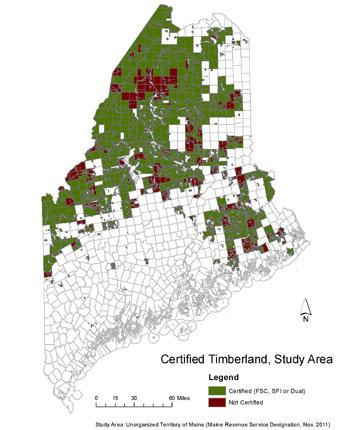Assessing Maine’s Certified Sustainable Harvest

Maine is a national leader in forest sustainability certification, with upwards of 10 million acres, or more than 50% of its timberland, certified by the Forest Stewardship Council (FSC) or the Sustainable Forestry Initiative (SFI). Despite certification's unprecedented rise in Maine, few studies have directly assessed its ecological or silvicultural impact, spurring increasing scrutiny of certification’s costs and benefits by both environmentalists and forest industry.
As a first step, NSRC researchers reviewed sustainability goals and criteria of FSC and SFI standards, then looked for areas of overlap with on-the-ground measures derived from the USDA Forest Service Forest Inventory and Analysis (FIA) database. On private, certified land, researchers found that total removals exceeded net growth between 1999 and 2012, whereas growth and harvest were in balance on public certified land. The imbalances on private land appear driven by intensive harvest of hardwood trees, though sawtimber (larger trees used by sawmills) and the region's most valuable commercial species — red spruce and sugar maple — showed the most significant imbalances. Of the species assessed, only balsam fir showed significantly more growth than harvest on private, certified land. Overall, FSC-certified lands showed a trajectory towards balance from 1999 to 2012; SFI remained statistically unchanged.
Findings are only a partial indicator of sustainability or compliance with certification standards. Confidential forest management plans may offer silviculturally sound explanations for the imbalances observed. However, given the clear variation in management outcomes observed amongst the study groups, more research is needed to better understand certification's impacts on the Northern Forest.
